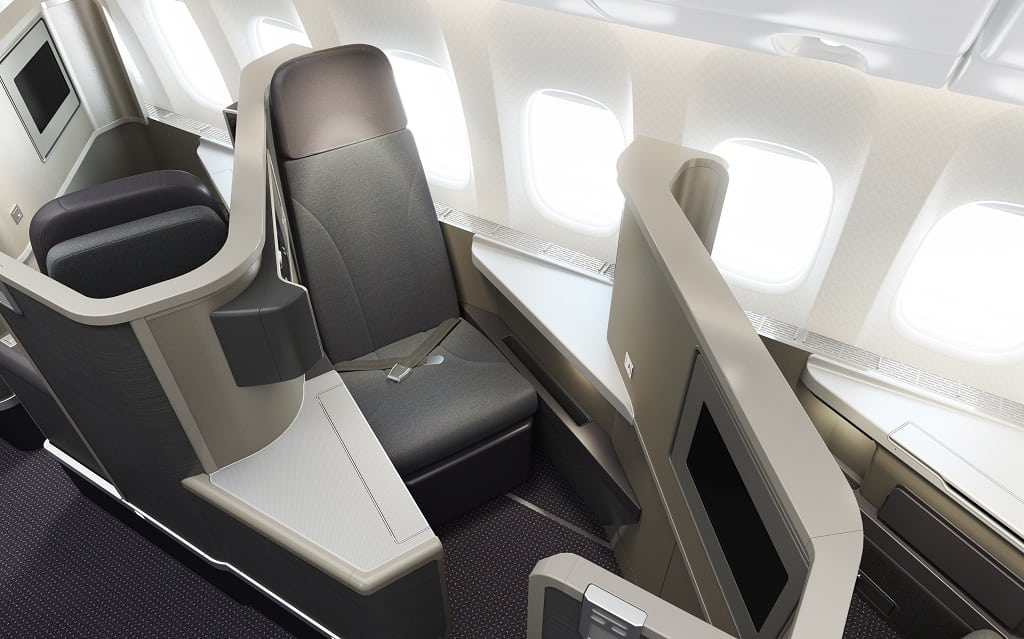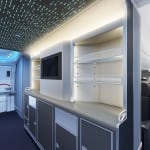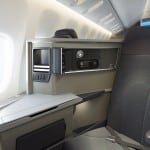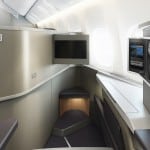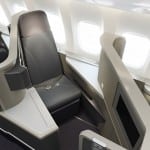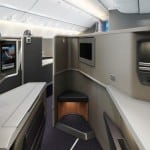Skift Take
American isn't the only brand thinking like this, but it is one of the few to so clearly articulate the shift.
- A walk-up bar
- The new business class seat.
- The new business class seat.
- The new coach class offering.
- The new business class seat.
- The new business class seat.
American Airlines doesn’t really want to be an airline anymore. They’ve been there. They’ve done that. They’ve moved on. And they want to bring you along with them.
While in Hamburg for the Aircraft Interiors Expo, we met up with Alice Liu, Managing Director of Onboard Products for American Airlines and her brand and design colleagues, Steven Moo-Young, Director-Onboard Product Planning & Design of Onboard Products, and Fernand Fernandez, Vice President of Global Marketing for the newly re-branded airline/hotel.
They gave us an audio-visual presentation, rolling images of their new cabin designs for the 777–200 on their three iPads in a carefully synchronized exchange of imagery and spiel.
They spoke passionately about their design philosophy and methodology, their careful process to evaluate and approve each modern design element.
We listed, and took copious notes, but we heard more than just their words. We heard their message. And it’s clear.
“We’re in the hospitality industry and these are our guests. We want to make them feel as though they’re at home,” Moo-Young told us. Later adding: “Our DNA is hospitality.”
When designing their new aircraft, they’ve replaced the galley entry with a “lobby bar,” decorated at the ceiling with that American DNA pattern. “It’s really quite a spectacular entrance,” Moo-Young tells us. “During flight there will be refreshments and snacks for our business class passengers to enjoy.”
As they describe the design details of their cabins, we notice the subtle choice of vocabulary. They’re not business class seats but business class “Suites” with Suite ID panels instead of seat numbers on the side where “guests” can request privacy by lighting up their “Do Not Disturb” sign.
What other airlines call lie-flat seats, American simply calls beds, for which American will provide comfortable duvets, and on which Moo-Young tells us the seat back is more “like a headboard at a fine hotel.”
There’s that word again. It’s a well-rehearsed speech, with the three presenting a unified front, and a solid message: this isn’t an aircraft anymore.
At least, that’s what American intend to achieve.
Liu describes their new hotel of the skies brand as “Life uninterrupted.”
“In the past,” she tells us, “The airplane … looked like an airplane. Why? You spend so much time there, it’s your living room, it’s your dining room, it’s your bedroom, it’s your study. It should be like home.”
Their description of the space reveals how American intend to brand this new sky-hotel, using phrases like “Lounge Environment,” for the cabin, describing it as “organic,” and capping that off with the design objective: “High-end sophisticated, but timelines.”
The “timeless” part is for business reasons. American need this design to endure a few years of service. They won’t be a boutique hotel. They’re not going to follow trends. Their aim is to ensure that guests feel more like they’re at the Intercontinental than on an intercontinental flight.
Moo-Young explains that their guests “have to live in the space.” They organize that space to “create a community feel.” When American’s “guests” travel with them, they should “feel welcome, and comfortable, and warm.”
The space at the front-end part of the sky-hotel, Moo-Young describes consists of “lots of surface area so when you transition from typing on your iPad to dinner you have lots of space for your items. You don’t have to constantly be putting things on your lap while your eating.” He emphasizes they’ve designed for, “Lot’s of height and also lots of privacy.”
Part of ensuring that privacy, is their new front-to-back nested suite configuration. But the front-to-back nesting is not just about customer comfort. Like any good hotel, American has also considered square footage. To make this sky-hotel profitable, American needs to increase the density of their premium product, and they want to do so without ruining the illusion of roominess, while also maintaining a sense of community, and ensuring those traveling together can enjoy each other’s company.
They create mood with “candlelight and amber at dinner time,” and a “nightlight of a very dim blue so you can see it but it won’t keep you awake,” says Moo-Young.
“It’s all about the details,” Liu adds. “We’ve thought about the experience.”
They’ve carefully studied the preferences of their guest, their life-style choices, their technology needs, their food preferences, even what they like best about their cars. Then they’ve blended all of it into a unique brand experience.
They told us that they developed their suites in “secret workshops” then patented them. American invested in a full-sized mock-up at one of these secret workshops before approving the final designs to install on board.
American treat their cabin design like an architectural project, because American considers their aircraft more real estate than a vehicle for transport.
This strategy will control the design of their entire fleet. Pretty soon all of American’s planes will be sky-hotels. Their program for completion is aggressive, with aims to finalize a fleet-wide changeover in a couple of years.
But the New American is not just one hotel, it’s two. If the front-end is the Intercontinental, then think of the back end as their Holiday Inn. American is furnishing that budget sky-hotel experience with new trim and seats equipped with large screens and power outlets.
They want their more budget-sensitive guests to also feel at home, but the main comfort feature of home at the back is entertainment. The American team assures us that guests in their budget-version sky-hotel will be able to enjoy the same entertainment as those in the front.
And, unlike most hotels, there’ll be lots to watch on American’s sky-hotel. Liu likes to point out that guests “could fly fifteen times around the world without consuming the same content.”
Recent changes in American’s loyalty program reflect the value they place on their prime real estate. Those Premium Suites are intended to bring in revenue and attract a select customer profile.
They’ve gone out of their way to provide product differentiation between the two aircraft sections. The New American does not intend to give up that Premium space to non-revenue travel as readily as they did in the past. But in the past passengers could only expect to get a souped-up Lay-Z-Boy at the front, and a warm cookie. In the past, American still thought it was an airline.
The problem now, for American’s grand hospitality plan is with their recent absorption of MainStay, sorry, USAirways. But the team didn’t address any plans for this airline, and during a previous interview Liu’s reply was tantamount to ‘we’ll get to that eventually.’
But will they?
The truth is American doesn’t have to. No one should be surprised if, in the very near future, the joint international routes of the two airlines are covered by exclusively by American’s own new aircraft and the US Airways’ existing fleet is slowly phased out, or relegated to continental and regional service within the U.S.
US Airways’ existing fleet is aging and heavy on mid-range and short-range aircraft. Plans to retire their long-range aircraft are already confirmed. The orders for mid-range they have on the books with Airbus will come out with American branding, and that branding will likely reflect US Airways’ repositioning in this new American hotel model: as a Holiday-Inn Express.
It makes sense. Of the two, American Airlines was always the international power-house, and focusing their energy on that hotel experience demonstrates a desire by New American to make longer flights attractive to high-paying customers, and comfortable (within reason) for everyone else.
“American Airlines is the way you want to get to where you want to go,” Moo-Young told us, “but in the meantime you can live your life as you do on the ground.”
No matter how you live your life, you can expect a hospitality experience to suit your needs from the new American (hotels) Airlines.
The Daily Newsletter
Our daily coverage of the global travel industry. Written by editors and analysts from across Skift’s brands.
Have a confidential tip for Skift? Get in touch
Tags: amenities, american airlines, in-flight
